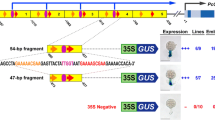Abstract
Several sites of nuclear protein interaction within the promoter region of theAntirrhinum majus floral meristem identity geneSQUAMOSA were detected using an electrophoretic mobility shift assay. One of these sites displayed a particularly clear interaction with nuclear protein extracted from inflorescences but not with nuclear protein extracted from young, non-flowering plants. This site could thus represent a binding motif for a transcriptional activator. A South-western screen of an inflorescence cDNA expression library resulted in the isolation of several cDNAs representing two different genes namedSBP1 andSBP2 (forSQUAMOSA-pROMOTERBINDINGP ROTEIN gene 1 and 2). Both genes encode highly similar protein domains which were found to be necessary and sufficient for binding DNA in a sequence-specific manner. This DNA-binding domain showed no similarity to known proteins in the databases. However, it is characteristic for a small family of gene products inA. majus and other plant species. Expression ofSBP1 and2 is developmentally regulated and their transcriptional activation precedes that ofSQUAMOSA. The data presented support the idea that members of the newly identifiedSBP gene family function as transcription factors involved in the control of early flower development.
Similar content being viewed by others
References
Bernier G (1988) The control of floral evocation and morphogenesis. Annu Rev Plant Physiol Plant Mol Biol 39:175–219
Carpenter R, Coen ES (1990) Floral homeotic mutations produced by transposon mutagenesis inAntirrhinum majus. Genes Dev 4:1483–1493
Coen ES (1991) The role of homeotic genes in flower development and evolution. Annu Rev Plant Physiol Plant Mol Biol 43:241–279
Coen ES, Meyerowitz EM (1991) The war of the whorls: genetic interactions controlling flower development. Nature 353: 31–37
Davies B, Schwarz-Sommer Z (1994) Control of floral organ identity by homeotic MADS-box transcripiton factors. Results and Problems in Cell Differentiation, Vol 20. Springer Verlag, Heidelberg, pp 235–259
Dignam JD, Lebovitz RM, Roeder RG (1983) Accurate transcription initiation by RNA polymerase II in a soluble extract from isolated mammalian nuclei. Nucleic Acids Res 11:1475–1489
Dingwall C, Laskey RA (1991) Nuclear targeting sequences — a consensus? Trends Biochem Sci 16:478–481
Green PJ, Kay SA, Lam E, Chua N-H (1989) In vitro DNA footprinting. In: Gelvin SB, Schilperoort RA (eds) Plant Molecular Biology Manual, Kluwer Academic Publishers, Dordrecht, Netherlands, pp B11:1–22
Hahn S (1993) Structure (?) and function of acidic transcription activators. Cell 72:481–483
Huijser P, Klein J, Lönnig W-E, Meijer H, Saedler H, Sommer H (1992) Bracteomania, an inflorescence anomaly, is caused by the loss of function of the MADS-box genesquamosa inAntirrhinum majus. EMBO J 11:1239–1249
Inamdar NM, Ehrlich KC, Ehrlich M (1991) CpG methylation inhibits binding of several sequence-specific DNA-binding proteins from pea, wheat, soybean and cauliflower. Plant Mol Biol 17:111–123
Izawa T, Foster R, Nakajima M, Shimamoto K, Chua N-H (1994) The rice bZIP transcriptional activator RITA-1 is highly expressed during seed development. Plant Cell 6:1277–1287
Koornneef M, Hanhart CJ, Van der Veen JH (1991) A genetic and phsiological analysis of late flowering mutants inArabidopsis thaliana. Mol Gen Genet 229:57–66
Lee I, Aukerman MJ, Gore SL, Lohman KN, Michaels SD, Weaver LM, John MC, Feldman KA, Amasino RM (1994) Isolation ofLUMINIDEPENDENS: a gene involved in the control of flowering time inArabidopsis. Plant Cell 6:75–83
Logemann J, Schell J, Willmitzer L (1987) Improved method for the isolation of RNA from plant tissue. Anal Biochem 163:16–20
Mandel MA, Gustafson-Brown C, Savidge B, Yanofsky MIT (1992) Molecular characterization of theArabidopsis floral homeotic geneAPET ALA1. Nature 360:273–277
Martinez-Zapater JM, Coupland G, Dean C, Koornneef M (1994) The transition to flowering inArabidopsis. In: Meyerowitz EM, Somerville C (eds)Arabidopsis. Cold Spring Harbor Laboratory Press, Cold Spring Harbor, New York, pp 403–434
Merkle DL, Berg JM (1991) Metal requirements for nucleic acid binding proteins. Methods Enzymol 208:46–54
Putterill NP, Robson F, Lee K, Simon R, Coupland G (1995) TheCONSTANS gene of Arabidopsis promotes flowering and encodes a protein showing similarities to zinc finger transcription factors. Cell 80: 847–857
Rhodes D, Klug A (1993) Zinc fingers. Sci Amer 2:32–39
Sambrook J, Fritsch EF, Maniatis T (1989) Molecular cloning: a laboratory manual. Cold Spring Harbor Laboratory Press, Cold Spring Harbor, New York
Schultz EA, Haughn GW (1993) Genetic analysis of the floral initiation process (FLIP) inArabidopsis. Development 119:745–765
Schwarz-Sommer Z, Huijser P, Nacken W, Saedler H, Sommer H (1990) Genetic control of flower development by homeotic genes inAntirrhinum majus. Science 250:931–936
Singh H, Clerc RG, LeBowitz JH (1989) Molecular cloning of sequence-specific DNA binding proteins using recognition site probes. BioTechniques 7:252–261
Sommer H, Beltrán J-P, Huijser P, Pape H, Lönnig W-E, Saedler H, Schwarz-Sommer Z (1990)Deficiens, a homeotic gene involved in the control of flower morphogenesis inAntirrhinum majus: the protein shows homology to transcription factors. EMBO J 9:605–613
Stubbe H (1966) Genetik und Zytologie vonAntirrhinum L. sect. Antirrhinum. VEB Gustav Fischer Verlag, Jena
Weigel D, Meyerowitz EM (1994) The ABCs of floral homeotic genes. Cell 78:203–209
Author information
Authors and Affiliations
Additional information
Communicated by J. Schell
Rights and permissions
About this article
Cite this article
Klein, J., Saedler, H. & Huijser, P. A new family of DNA binding proteins includes putative transcriptional regulators of theAntirrhinum majus floral meristem identity geneSQUAMOSA . Molec. Gen. Genet. 250, 7–16 (1996). https://doi.org/10.1007/BF02191820
Received:
Accepted:
Issue Date:
DOI: https://doi.org/10.1007/BF02191820




